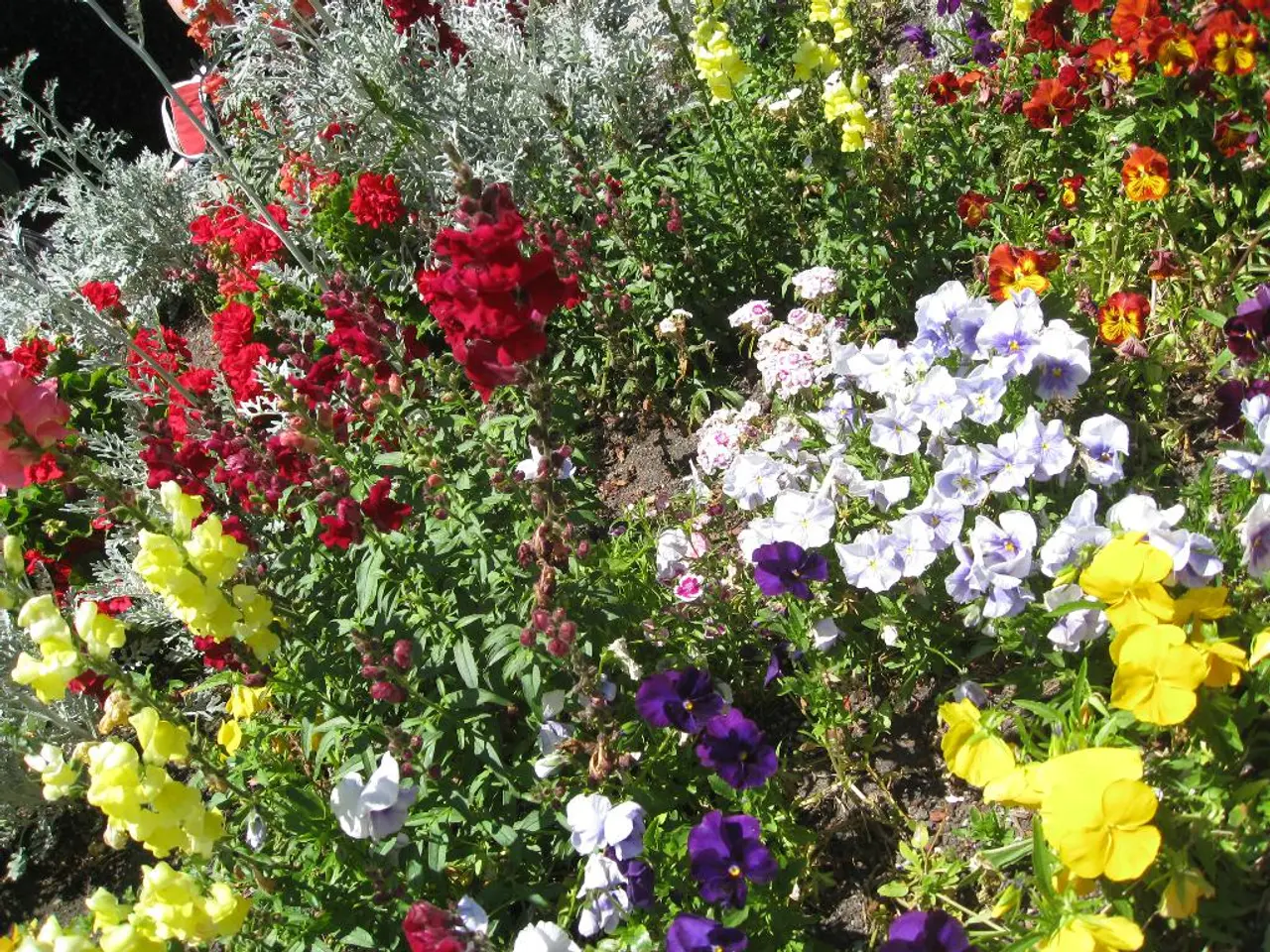Blooming Treasures of the USA: 15 Wildflowers Perfect for Your Summer Floral Haven
Top 15 Native American Wildflowers for a Low-Maintenance, Pollinator-Friendly Garden
Transform your outdoor space into a vibrant haven for pollinators with these 15 native wildflowers. These resilient plants are not only easy to maintain but also thrive in local climates and resist common pests.
- Joe-Pye Weed (Eutrochium spp.) - This tall perennial boasts pink/purple flower clusters that attract bees and butterflies. It thrives in zones 4-8, tolerates moist soil, and prefers part shade.
- Lanceleaf Blanket Flower (Gaillardia aestivalis) - A clumping ground cover or flower with yellow/red fan-shaped petals, it is suited for full sun and well-drained soils. Hardy in zones 3a-10b.
- Marsh Hibiscus (Hibiscus coccineus) - With large, deep red flowers, this plant adds tropical color to your garden. It grows in zones 8a-10b and is tolerant of wet and some dry soils.
- Catmint (Nepeta spp.) - Easy-to-grow with lavender blue/pink flowers and gray-green foliage, it blooms through summer. Thriving in USDA zones 4-8, it is considered drought-tolerant and fast-growing.
- Coral Bells (Heuchera spp.) - This mounding perennial offers bell-shaped nectar-rich flowers that attract hummingbirds and butterflies. It grows slowly, making it ideal for containers, and is hardy in zones 4-9.
- Purple Prairie Clover (Dalea purpurea) - A good pollinator plant that attracts bumblebees, it is drought-tolerant and suited for no-irrigation landscapes in lower foothills or prairies.
- Bee Balm (Monarda spp.) - Tubular nectar-rich flowers favored by bumblebees and hummingbirds, it blooms in mid to late season and supports diverse pollinators.
- Penstemon (Penstemon spp.) - Tubular flowers attracting hummingbirds and bees, it blooms in mid to late season and prefers well-drained soil.
- Trumpet Honeysuckle (Lonicera spp.) - Tubular flowers important for hummingbirds, it requires minimal maintenance and attracts pollinators in mid to late season.
- Cup Plant (Silphium perfoliatum) - Large, nectar-rich yellow flowers support bumblebees and hummingbirds, making it a late-season bloomer.
- Sulfur Buckwheat (Eriogonum umbellatum) - A drought-tolerant wildflower supporting pollinators, it thrives in dry conditions.
- Arrowleaf Buckwheat (Eriogonum compositum) - Another buckwheat species attractive to pollinators and low-water.
- Goldenrod (Solidago spp.) - A late-season nectar source critical for bees and butterflies, it is drought-tolerant and hardy.
- Fernsleaf Yarrow (Achillea filipendulina) - A tough, drought-resistant perennial with nectar-rich flowers, it supports pollinators.
- Milkweed (Asclepias spp.) - Essential for butterflies, especially monarchs, it thrives in full sun and well-drained soil, offering nectar and serving as a host plant.
These species are native across various parts of North America and are favored by a range of pollinators such as bees, butterflies, and hummingbirds. Many tolerate drought, poor soils, and minimal watering once established, making them excellent choices for sustainable, pollinator-friendly gardens.
Consider your specific USDA hardiness zone and soil conditions when selecting among them to ensure optimal growth and pollinator support.
In addition to these wildflowers, the Shasta Daisy (Leucanthemum × superbum) brightens up any summer garden with its classic daisy charm. Unlike its invasive cousin, the oxeye daisy, the Shasta daisy is a well-behaved hybrid native to the U.S., offering long-lasting blooms and attracting beneficial pollinators. It requires full sun with well-draining soil and regular deadheading.
Butterfly Weed (Asclepias tuberosa) blooms in bright orange clusters on clean, upright stems and is a magnet for Monarch butterflies. It prefers full sun and well-drained soil, and pods should be allowed to mature for seed dispersal unless self-seeding is unwanted.
Lupine (Lupinus spp.) has tapered spikes of purple, blue, or pink flowers over green palmate leaves and enriches soil by fixing nitrogen. It is loved by bumblebees and brightens cooler areas. It thrives in sun to part shade, well-drained, sandy soil, and may require support in poor conditions.
- To create a captivating home-and-garden decor, consider planting annuals like Shasta Daisies and Butterfly Weeds, adding charm and attracting beneficial pollinators.
- For a low-maintenance garden that supports native pollinators, incorporate perennials such as Joe-Pye Weed, Catmint, Coral Bells, and Purple Prairie Clover.
- Don't forget about the lush undergrowth provided by perennials such as Lanceleaf Blanket Flower, Marsh Hibiscus, and Fernsleaf Yarrow, which add color and serve as vital food sources for pollinators.
- Native wildflowers such as Sulfur Buckwheat, Arrowleaf Buckwheat, and Goldenrod, thrive in dry conditions and contribute to a sustainable, pollinator-friendly lifestyle.
- Incorporate decorative elements made of natural materials like stone, wood, or recycled materials to enhance the organic feel of your pollinator-friendly garden.
- As you cultivate your home-and-garden ecosystem, ensure to maintain a balance between plants that offer nectar, pollen, and host facilities for caterpillars, creating a thriving habitat for a diverse range of pollinators.




